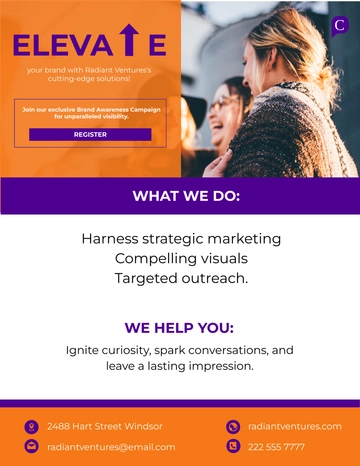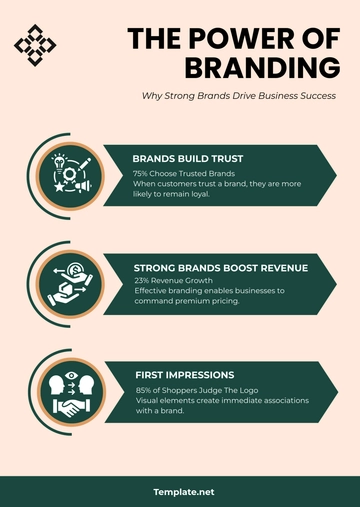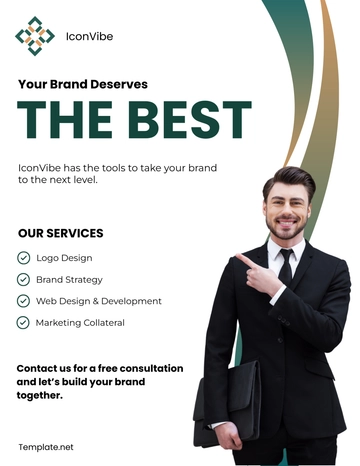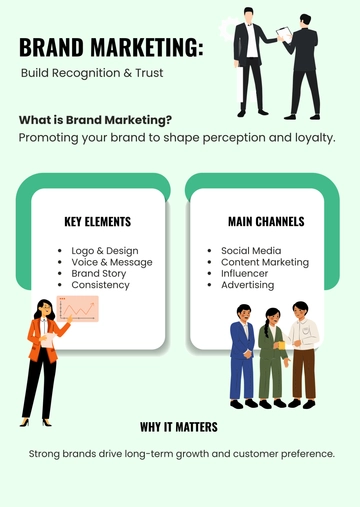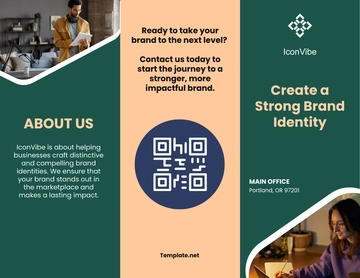Free Brand Narrative Advertising Development Guide
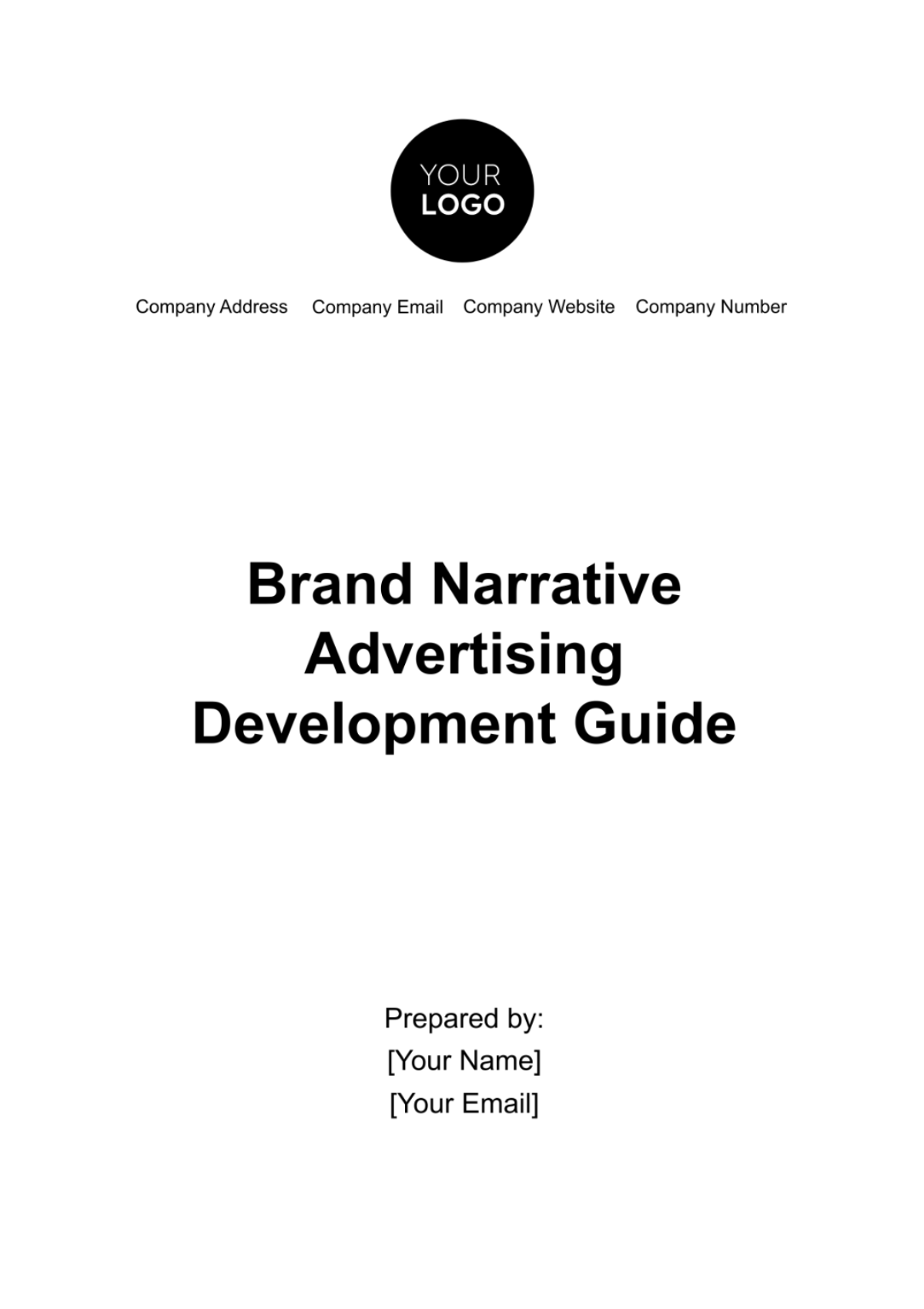
I. Introduction
Purpose Of The Guide
This Brand Narrative Advertising Development Guide serves as an indispensable compass, helping marketing teams and creative professionals go through crafting resonant brand narratives when creating advertising campaigns.
Target Audience
Tailored for the discerning minds steering the course of advertising strategy, this guide is expressly designed for marketing managers, seasoned copywriters, and visionary creative directors. It allows these key stakeholders to craft narratives that transcend the ordinary and captivate diverse audience segments.
Scope And Objectives
The systematic process of building brand narrative development. From the genesis of analysis to the continuous refinement cycle, its scope is to give professionals the knowledge and tools needed to create advertising campaigns that impactfully echo our brand narrative. The objectives herein are not merely instructional but aspirational; Cultivating an environment where creativity converges with strategy to yield enduring campaigns that stand the test of time.
II. Brand Analysis
Defining Brand Identity
In this pivotal stage, we will go through the essence of the brand, meticulously defining its identity by clearing up the core elements that cover its character, purpose, and overarching persona, and analyze the values, principles, and historical context that form the foundation of the brand's existence.
Mission And Core Values
Express the brand's mission and core values, fashioning a narrative structure that not only reflects the brand's moral compass but also resonates with the aspirations and sensibilities of the target audience. This section serves as the guide directing the trajectory of the narrative towards authenticity and meaningful connection. Here are our mission and core values:
Core Values:
Authenticity: We believe in the power of genuine storytelling, striving to convey the true essence of our brand and connect with our audience on a personal level.
Creativity: We create a culture of creativity and innovation, pushing boundaries to develop narratives that stand out and captivate the imagination.
Integrity: Honesty and transparency are at the core of our narrative development process. We uphold the highest ethical standards in all our communications.
Empathy: Understanding the emotions and needs of our audience is fundamental. We approach narrative development with empathy, creating stories that resonate and inspire.
Fun and Passion: We approach our work with a sense of joy and passion, infusing creativity and enthusiasm into every narrative we develop. We believe that a joyful process leads to exceptional outcomes.
Unique Selling Propositions (USPs)
Explore the brand's Unique Selling Propositions (USPs), those distinct facets that set it apart from its competitors. Here are some of [Your Company Name]’s USPs:
Strategic Customization: Tailoring strategies to [Your Company Name]'s
individual needs. We don't believe in one-size-fits-all solutions, ensuring maximum impact and relevance in every campaign.
Data-Driven Precision: Precision marketing fueled by data intelligence. Harnessing the power of data analytics, we go beyond intuition.
Innovative Storytelling: Elevating [Your Company Name]’s brands through captivating narratives. We understand that storytelling is highly critical for effective marketing.
360-Degree Integration: Seamless integration across all marketing channels. We break down silos, whether it's digital, social, traditional media, or experiential marketing, our integrated approach ensures a cohesive brand message across all touchpoints.
Performance Transparency: Complete transparency in tracking and reporting. We believe in open communication. Our clients have real-time access to performance metrics, analytics, and campaign insights.
Competitive Landscape
Map out rivals and allies alike. Illuminate the contextual backdrop against which the brand narrative will unfold, identifying opportunities for differentiation and strategic positioning. This discerning analysis lays the foundation for a narrative that not only captivates but strategically outshines in the market. Here's a discerning analysis covering key aspects:
1. Industry Position:
Strengths: Evaluate the company's market share, reputation, and brand recognition. A strong industry position suggests effective past strategies and customer trust.
Weaknesses: Identify any challenges or gaps in the company's position, such as limited market presence or brand visibility.
2. Service Portfolio:
Strengths: Assess the comprehensiveness and innovation of the services offered. A diversified and cutting-edge service portfolio can set a company apart from competitors.
Weaknesses: Identify any gaps or limitations in the services offered compared to competitors. Lack of a specific capability might impact competitiveness.
3. Client Portfolio:
Strengths: Examine the quality and diversity of the client base. A robust and varied client portfolio indicates a broad industry understanding and the ability to cater to different needs.
Weaknesses: If the company relies heavily on a few clients or a specific industry, it might be vulnerable to economic shifts or changes in that sector.
4. Talent and Expertise:
Strengths: Assess the skill set and expertise of the company's team. A talented and experienced workforce can contribute to innovative strategies and high-quality execution.
Weaknesses: A lack of skilled professionals or a high turnover rate may affect service quality and continuity.
5. Market Trends and Adaptability:
Strengths: Determine how well the company adapts to emerging trends in marketing. Flexibility and a proactive approach to industry changes can be advantageous.
Weaknesses: Resistance to change or slow adaptation to new trends may result in missed opportunities or a decline in competitiveness.
III. Audience Profiling
Identifying Target Demographics
In this section, we will delve into the target audience's demographics. Utilize data-driven insights of their age, gender, location, income level, and other pertinent characteristics. The following table provides a template for organizing and analyzing demographic data:
Demographic | Description | Key Insights |
Age Range | 18-24 | High digital engagement, trend-sensitive |
Gender | Male | Preference for tech-related products |
Location | Urban areas | Access to advanced services and amenities |
Income Level | Middle To High | Willingness to invest in quality products |
Behavioral Analysis
Let’s go through the behavioral patterns exhibited by the target audience. Identify their online and offline activities, preferences, and decision-making processes. Use the following table as a guide to categorize and analyze behavioral data:
Behavior | Description | Implications For Narrative |
Online Presence | Active on social media platforms | Emphasize digital outreach |
Purchase Habits | Prefers online shopping over traditional retail | Highlight e-commerce benefits |
Content Consumption | Engages with video content | Integrate visual storytelling |
Audience Preferences And Tendencies
Explore the distinct preferences and tendencies that shape the audience's choices. Consider their interests, hobbies, and cultural influences. Use the table below to document and leverage these insights for narrative development:
Preference | Description | Narrative Alignment |
Tech Enthusiast | Interest in the latest technological trends | Emphasize product innovation |
Sustainability | Values eco-friendly practices | Highlight the brand's green initiatives |
Entertainment | Enjoys engaging and entertaining content | Infuse storytelling with humor and excitement |
By profiling the target audience and utilizing structured tables for data organization, the narrative development process gains a solid foundation rooted in a new understanding of the audience's demographics, behaviors, preferences, and tendencies. This strategic approach ensures that the crafted narrative resonates authentically and effectively with the intended audience.
IV. Story Ideation And Conceptualization
Brainstorming Sessions
Initiate dynamic brainstorming sessions involving cross-functional teams to boost creativity and generate diverse narrative concepts. Encourage open dialogue and the exploration of unconventional ideas to unlock innovative storytelling possibilities.
Aligning Concepts With Brand Identity
Ensure a seamless integration of narrative concepts with the fundamental elements of the brand identity, including its values, mission, and unique selling propositions. Thoroughly assess each concept's alignment to maintain a cohesive and authentic brand representation.
Crafting Engaging Storylines
Transform selected concepts into captivating storylines that captivate the target audience. Develop narratives that unfold organically, building emotional connections and sustaining audience engagement throughout the storytelling journey. Incorporate compelling characters, impactful visuals, and resonant themes to bring the narrative to life and leave a lasting impression. Here are some examples of storylines that can be used:
Random Acts of Kindness: Capture instances where the brand becomes a catalyst for acts of kindness and generosity, illustrating its impact on building a compassionate community.
Remote Work Realities: Explore the challenges and victories of remote workers, highlighting how the brand enhances productivity and work-from-home experiences.
Celebration Unleashed: Capture the excitement and joy of celebrations, illustrating how the brand adds a special touch to birthdays, holidays, and memorable moments.
V. Visual And Verbal Elements
Integrating Visual Components
Effectively integrate visual components into the brand narrative, ensuring alignment with the brand's visual identity. This involves the strategic use of graphics, imagery, and color schemes to enhance the overall visual appeal and reinforce the narrative.
A. Action Points
Visual Consistency: Maintain consistency in visual elements across all advertising materials.
Brand Imagery Guidelines: Develop guidelines for the use of imagery that aligns with the brand's image and resonates with the target audience.
Color Scheme Alignment: Ensure that the chosen color scheme complements the brand identity and evokes the intended emotions.
Consistent Branding In Imagery
Maintain a cohesive and recognizable brand image through consistent branding in imagery. This involves establishing a visual language that reinforces the brand narrative and fosters brand recall among the audience.
A. Action Points
Branded Visual Elements: Incorporate branded elements consistently in images to enhance brand recognition.
Storytelling Through Imagery: Use imagery as a storytelling tool, conveying key brand messages visually.
Adherence To Guidelines: Ensure that all visual elements adhere to established brand guidelines for a unified visual identity.
Verbal Messaging And Tagline Development
Craft compelling verbal content, including messaging and taglines, to reinforce the brand narrative. This involves creating impactful and memorable language that resonates with the target audience and aligns with the overall storytelling strategy.
A. Action Points
Message Clarity: Ensure clarity and conciseness in verbal messaging to convey the intended brand message effectively.
Tagline Impact: Develop a tagline that encapsulates the essence of the brand narrative and leaves a lasting impression.
Consistent Tone: Maintain a consistent tone of voice across all verbal elements for a unified brand communication strategy.
Deadline | Responsible Party | Action Point |
2050-05-15 | Design Team | Maintain Visual Consistency |
2050-05-20 | Creative Director | Develop Brand Imagery Guidelines |
2050-05-25 | Art Director | Align Color Scheme With Brand Identity |
2050-06-01 | Graphic Design Team | Incorporate Branded Elements In Imagery |
2050-06-10 | Copywriting Team | Use Imagery For Storytelling |
2050-06-15 | Marketing Team | Adherence To Branding Guidelines |
2050-06-20 | Copywriting Team | Ensure Message Clarity |
2050-06-25 | Copywriting Team | Develop Impactful Tagline |
2050-07-01 | Marketing Team | Maintain Consistent Tone |
VI. Multi-Channel Integration
In this crucial phase, the guide delves into the strategic integration of the brand narrative across diverse advertising channels.
Choosing Advertising Platforms
Careful consideration is given to selecting the most effective platforms based on the target audience's behavior and preferences. This section outlines a systematic approach to identifying and utilizing platforms that align with the brand's objectives. Here are examples of advertising platforms that [Your Company Name] can use:
A. Google Ads
B. Facebook Ads
C. Instagram Ads
D. LinkedIn Advertising
E. YouTube Advertising
Crafting Channel-Specific Narratives
Recognizing the unique characteristics of each channel, the guide provides insights on tailoring the narrative for optimal resonance. Emphasis is placed on maintaining consistency while adapting the message to suit the nuances of different platforms.
Ensuring Consistency Across Channels
A pivotal aspect of this integration involves careful planning to maintain a unified brand experience. The guide provides strategies to ensure coherence in messaging, visuals, and overall brand representation across all chosen advertising channels. This consistency enhances brand recall and reinforces the narrative's effectiveness, building up a cohesive and impactful campaign presence.
VII. Narrative Testing
Implementing Focus Groups
Conduct in-depth focus group sessions with representative members of the target audience. Gather qualitative insights into their perceptions and reactions to the developed brand narrative.
Here are the types of focus groups that [Your Company Name] should use:
Focus Group Type | Purpose and Characteristics |
Exploratory Focus Group | Purpose: Gather insights on general opinions, attitudes, and perceptions. Characteristics: Small group size, open-ended discussions, participants encouraged to share freely, ideal for uncovering initial thoughts and ideas. |
Diagnostic Focus Group | Purpose: Assess reactions to specific stimuli (e.g., ads, products). Characteristics: More structured discussions, use of stimuli like prototypes or ads, in-depth exploration of participant reactions and feedback, suitable for evaluating specific elements or concepts. |
Strategic Planning Focus Group | Purpose: Inform long-term strategies and decisions. Characteristics: Larger group size, diverse participant backgrounds, guided discussions on strategic topics, ideal for gathering input on brand positioning, market trends, and future planning. |
Collecting And Analyzing Feedback
Systematically collect feedback from focus groups, utilizing structured surveys and open-ended questions. Analyze the gathered data to identify patterns, preferences, and areas for improvement.
VIII. Implementation Plan
Detailed Execution Strategy
Craft a meticulous plan outlining the step-by-step execution of the brand narrative across chosen advertising channels. Specify tasks, responsibilities, and timelines to ensure a seamless and coordinated implementation.
Timelines And Milestones
Define clear timelines and key milestones for each phase of the implementation. Establish deadlines for content creation, design production, and campaign launch to maintain project momentum.
Budget Considerations
Provide a comprehensive breakdown of budgetary allocations for each aspect of the implementation. Detail expenses related to content creation, advertising space, and any additional resources required for a successful campaign rollout.
IX. Performance Metrics
Establishing Key Performance Indicators (KPIs)
Define a set of clear and measurable Key Performance Indicators (KPIs) to gauge the success of the advertising campaign. These indicators should align with the overarching goals of the brand narrative and provide quantifiable benchmarks for assessment.
Data Monitoring And Analysis
Implement many durable data monitoring mechanisms to track the identified KPIs throughout the campaign lifecycle. Utilize advanced analytics tools to gather meaningful insights into audience interactions, engagement levels, and conversion rates.
Assessing Audience Engagement And Brand Perception
Evaluate audience engagement by analyzing metrics such as click-through rates, social media interactions, and website traffic. Additionally, conduct sentiment analysis and brand perception surveys to measure the impact of the narrative on audience perception and sentiment.
Iterative Improvement
Continuous Evaluation Process
Establish a systematic approach for ongoing evaluation, emphasizing the need for regular assessments of the advertising campaign's performance.
Adapting The Narrative For Sustained Effectiveness
Develop a dynamic strategy for adapting the brand narrative based on insights gained from continuous evaluation and feedback, ensuring its relevance and impact throughout the campaign's lifecycle. Implement changes as needed to optimize audience engagement and overall campaign success.
Conclusion
The Brand Narrative Advertising Development Guide provides a roadmap for creating impactful and resonant brand narratives within the realm of advertising. By navigating through the systematic steps outlined in this guide, marketing teams and creative professionals can forge narratives that not only reflect the essence of the brand but also captivate the identified target audience.
- 100% Customizable, free editor
- Access 1 Million+ Templates, photo’s & graphics
- Download or share as a template
- Click and replace photos, graphics, text, backgrounds
- Resize, crop, AI write & more
- Access advanced editor
Discover the ultimate solution for crafting compelling brand narratives with Template.net's Brand Narrative Advertising Development Guide Template. This editable and customizable tool seamlessly integrates an Ai Editor Tool, empowering you to effortlessly create impactful advertising campaigns. Elevate your brand storytelling and captivate your audience like never before with this essential resource.






